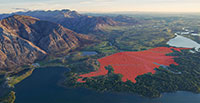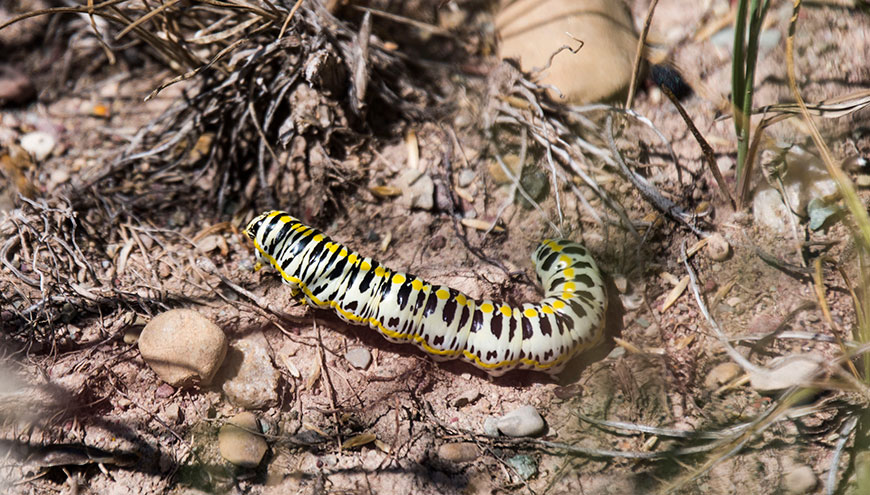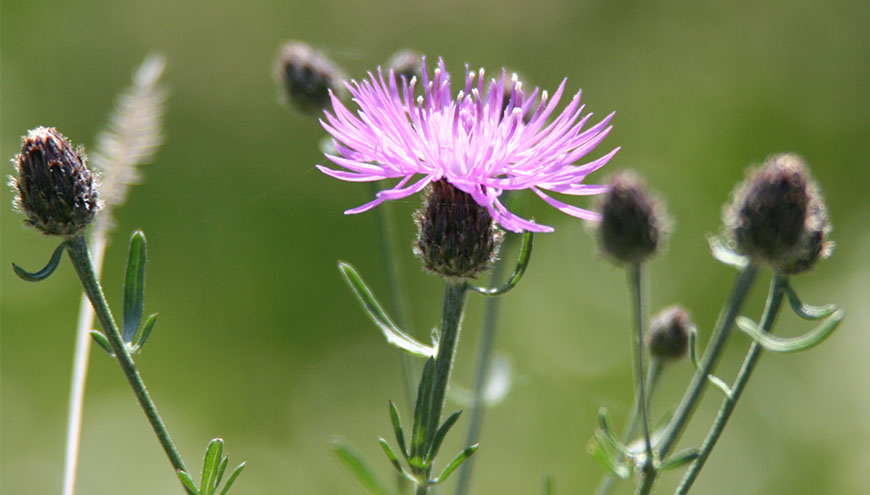
Half-moon hairstreak butterfly
Waterton Lakes National Park
One special invertebrate that calls Waterton Lakes National Park home is the endangered half-moon hairstreak butterfly.
This small, brown butterfly is known to exist in nine locations in Canada: eight in British Columbia and only one in Alberta, in Waterton Lakes National Park on a grassland area known as the Blakiston Fan.
This butterfly has black spots with white rings around them on its wings. Male half-moon hairstreaks have a wingspan of approximately 25 mm (about the size of a loonie). Females have larger and paler wings than the males.
The half-moon hairstreak's eggs are greenish white, and the caterpillar is light green with whitish lateral chevrons and a dark brown head.
Fun facts
- The half-moon hairstreak that calls Waterton Lakes National Park home is unlike many other species of hairstreaks, it has no “tail” on the hindwing.
- Butterflies are important to the ecosystem, both as a prey species and a pollinator. A diverse population of butterflies can indicate that an ecosystem is healthy and flourishing.
Protecting the half-moon hairstreak butterfly
Transcript
SOS! Half-moon hairstreak butterfly in distress!
The half-moon hairstreak and its habitat are protected under the Species at Risk Act
In Alberta, Waterton Lakes National Park is the only place where the half-moon hairstreak butterfly exists
It lives on a floodplain known as the Blakiston Fan
The area is threatened by natural disturbances
And invasive plants
Parks Canada and the Calgary Zoo are working together
To protect and restore the half-moon hairstreak population
Teams use monitoring, habitat restoration and research to understand the butterfly’s life cycle
These research methods play a crucial role in the butterfly’s survival
The half-moon hairstreak depends on some of the most beautiful wildflowers in the park
It relies on native plants like lupines for food and a safe place to reproduce
Half-moon hairstreaks are important to the ecosystem
Both as a prey species and as a pollinator
Butterflies are important indicators of a healthy habitat
They are beautiful and fascinating insects to observe
Each summer, Parks Canada shares the story of the half-moon hairstreak with visitors
By staying on paths and not trampling on plants
And by cleaning equipment such as boots and bikes to prevent the spread of invasive plants
You help protect the half-moon hairstreak butterfly!
A special thank you to the Calgary Zoo for collaborating on this project and providing footage.
Why the half-moon hairstreak matters
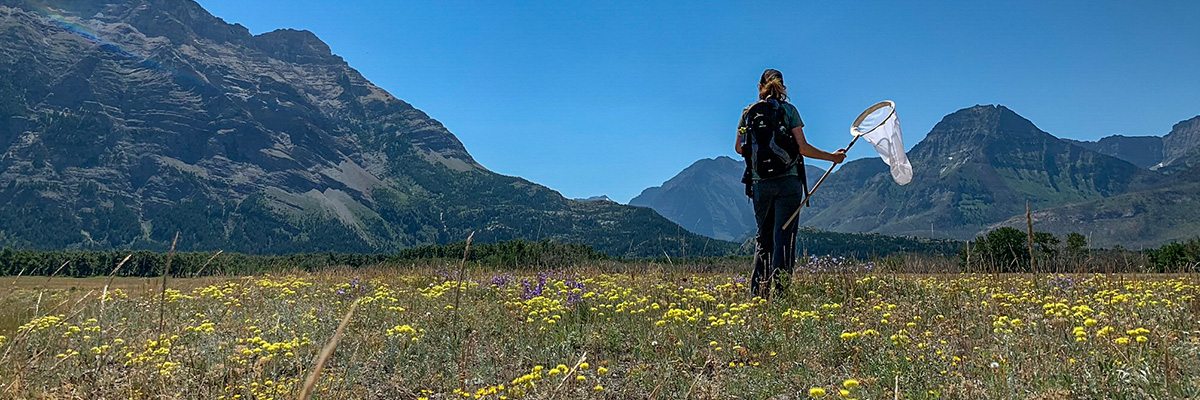
Species at risk
In 2006, the half-moon hairstreak butterfly was listed as an endangered species under the Species at Risk Act (SARA). This means that Parks Canada gives it special attention in Waterton Lakes National Park.
The Blakiston Fan, the butterfly's only known home in Alberta, was listed as Critical Habitat in 2016. This habitat is an alluvial fan consisting of dry grasslands on soils that drain quickly. The area is subject to flooding.
Species at risk in Waterton Lakes National Park
A 2018 survey indicated the Waterton Lakes population of the half-moon hairstreak butterfly has experienced a serious decline.
This decline may be due to habitat destruction caused by invasive plants like spotted knapweed. The population of half-moon hairstreaks in Waterton Lakes is threatened by these invasive plants that compete with native plants, necessary for the butterfly’s survival.
Natural disasters such as floods and fires can also be devastating to this isolated population.
Wild about wildflowers

Wildflowers are important to all stages of the half-moon hairstreak's life.
Silky and silvery lupine wildflower species are essential for breeding. Half-moon hairstreaks lay eggs by lupines in the summer months. When the caterpillars hatch the following spring, their main food source is that same lupine.
Nectar from plants such as yellow buckwheat and Missouri goldenrod are other important food sources.
Caterpillars transform once again to emerge as adult butterflies. Adults only live for six to 14 days. Males are more active than females, searching for a mate and patrolling and defending high shrubs in their environment.
What Parks Canada is doing to help the half-moon hairstreak
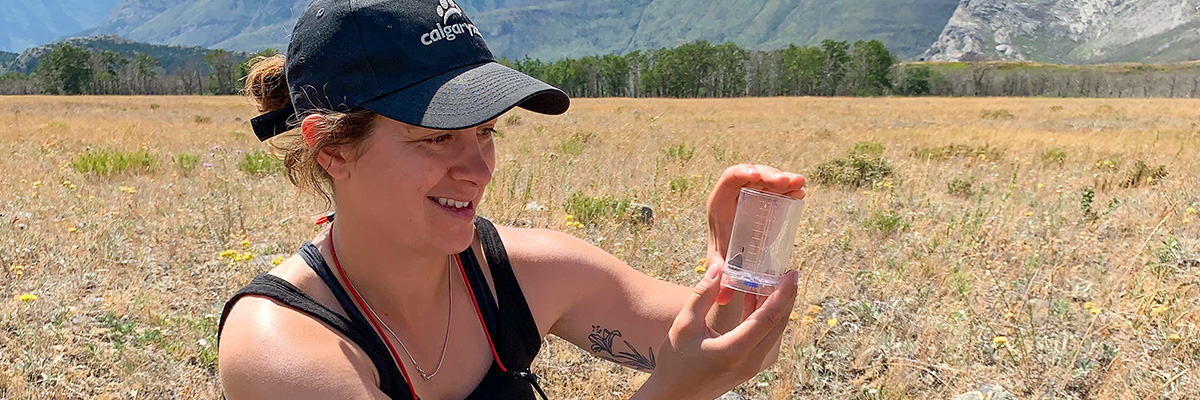
Parks Canada is working with the Wilder Institute/Calgary Zoo to understand this small insect and what will best help it survive. They are sharing knowledge and conservation techniques to help protect and restore the amazing half-moon hairstreak butterfly.
This program will greatly improve understanding of the secretive life history of the half-moon hairstreak. Researchers and Parks Canada want to better understand the butterfly’s different life stages, survival rates, behaviour and how they interact with other species. This will help determine conservation actions and management practices.
Other conservation actions include assessing and restoring the butterfly’s habitat, and managing invasive plants.
Watch more from the Wilder Institute/Calgary Zoo: Wilder Side Pollinators
How you can help

- PlayCleanGo
- Clean equipment such as boots, bikes, canoes, kayaks, paddleboards and also pets before arriving in the park, to prevent the spread of invasive plants and animals.
- Leave No Trace
- Stay on roads, paths and marked trails when hiking, and take extra care to not crush or pick any plants.
- Volunteer
- Become a habitat hero! Volunteer to remove harmful invasive plants from the park.
Related links
- Date modified :
